
Your customers are passionate about The Ultimate Driving Machine. They had many options when it came time to buy a vehicle, but they selected a BMW because they wanted to enjoy its amazing performance.
Just as your customers specifically picked a BMW to be their car, they specifically selected your shop to ensure that their BMW passion is a long-term relationship. They count on you to keep their BMWs in optimal condition, ready to go at any time, wherever they want, for as long as they are an owner. To fulfill the trust they’ve placed in you requires that you do more than just follow recommended service intervals. You are also responsible for using the oils, lubricants, and other fluids specified by BMW.
These fluid recommendations didn’t just materialize out of thin air. As part of its ongoing commitment to continually raising the performance bar, BMW engineers invested long hours running demanding test procedures to evaluate many different products. And the BMW engineers didn’t work alone. They often shared testing and analysis duties with their counterparts from the fluid manufacturers and refiners. With an attention to detail that matches BMW’s approach to designing and building cars, this product testing has resulted in a very specific set of recommendations on what works best in a BMW.
To cut corners or deviate from any recommended fluid could compromise the performance, reliability and longevity your customers expect from their vehicles. Make sure every fluid you use meets BMW’s standards.
Engine Oil
Since 1999, BMW, like some other premium carmakers, has used synthetic engine oil as its factory fill and recommended replacement. But Bayerische Motoren Werke has done other carmakers one better by developing its own brand of synthetic—BMW High Performance Synthetic Oil, a 5W-30 with SJ/CF ratings, that can be used in the BMW gasoline engines you find in North America and the diesels the company offers in other countries. The oil is packaged in both quarts (P/N 07 51 017 866) and bulk dispensing barrels (P/N 07 51 0 022 545).
For motorsports applications, including M3, M5, and Z8 applications, BMW recommends its BMW High Performance Synthetic Oil Castrol RS SAE 10W-60 (P/N 51 0 009 420).
BMW is very clear on this point: “It is recommended to use BMW High Performance Synthetic Oil in 1999 model year and later BMW models and recommend to use either BMW High Performance Synthetic Oil, High Performance Mineral Oil or one of today’s highly advanced brand name lubricating oils conforming to API classification SH or higher in 1998 and earlier BMW models.â€
The use of synthetic oil allowed BMW to extend normal service oil change intervals up to 15,000 miles, far longer than conventional, petroleum-based oils can endure. But this longer oil change interval is only one advantage of synthetic, and it isn’t even the greatest advantage.
Many different tests are done to evaluate engine oil performance, including anti-wear, resistance to oxidation and sludge formation, ability to keep the internal parts clean, and “viscosity consistency†which is a measure of how well oil maintains its viscosity rating over a wide range of temperatures. In every performance test, synthetics beat mineral or petroleum-based oils.
Oil At Work
If lubrication and/or friction reduction was oil’s only job, it would be relatively easy to produce and refine oil. But at the same time oil is lubricating, it must also:
- Clean the engine by holding microscopic contaminants in suspension until the particles can be trapped and held in the oil filter.
- Reduce internal engine temperature by absorbing and redistributing heat energy.
- Seal the spaces between the piston grooves, rings and cylinder walls as the piston travels up and down.
- Reduce engine wear by cutting friction and absorbing the impact force between the connecting rod bearings and crankshaft rod journals when the piston changes its direction of travel.
- Cling to internal surfaces to provide lubrication and protection during start-up until the oil is flowing normally.
- Maintain viscosity at a wide range of temperatures. Oil that gets too thick when it’s cold won’t be able to flow swiftly and smoothly enough during start-up, causing rod knock and rapid wear. Oil that thins out too much when hot won’t provide proper film strength. BMW synthetic oil maintains a very consistent viscosity. It will flow smoothly during a cold start-up and still provides excellent lubrication at very high temperatures.
- Resist oxidation. Any oil, synthetic or petroleum, will fail if it becomes oxidized. To prevent oxidation, the additives added to oils during refining contain an oxidation inhibitor. These inhibitors work better in synthetic oil.
Through Thick and ThinViscosity is a rating of how smoothly oil pours at different temperatures. In the United States, viscosity ratings are based on test procedures developed by the Society of Automotive Engineers (SAE). A low viscosity number indicates a “thin†oil that flows easily. A high viscosity number means the oil is “thick†and will resist breakdown at high temperatures. |
Because synthetic oil works so well, should you recommend it to customers with older (prior to 1999) BMWs? The answer is a qualified “yes.â€
On 1980 or older models, there can be serious problems with the engine seals because synthetics are not compatible with some obsolete types of seals. For these vehicles, don’t use a synthetic if the seals have not been replaced. Seals made after 1980 are compatible with synthetic oils.
Before converting any engine from conventional to synthetic, however, you should make sure there are no oil leaks. Because synthetics are more “slippery†than conventional oils, a leak with petroleum-based oil can become a gusher with synthetics. For maximum protection, sell your customer an engine cleaning and a “black light†dye test to spot any leaks before converting from mineral based to synthetic oil. Obviously, fix any leak before making the oil switch.
On the question of using any aftermarket oil additives, BMW is again very clear — don’t do it. According to BMW, “The use of engine oil additives is not recommended and not necessary on BMW engines.â€
Coolant
BMW is fairly liberal on coolant use, requiring only that all cooling systems be filled with a “reputable brand name ethylene glycol long-term antifreeze having corrosion inhibitors that are compatible with aluminum radiators.â€
But this becomes a risk for you and your reputation because now some aftermarket manufacturers are selling generic antifreeze with essentially the same formula as the troublesome one used in certain domestic cars that everybody in the auto service business has heard of, and making the same claims about extended change intervals.
The exclusively-formulated antifreeze that BMW specifies and makes available through its dealerships’ parts departments is a different story. It’s an ethylene glycol-based silicated OAT (Organic Acid Technology) formula, which contains no nitrates or phosphates, and has been chemically designed to prevent excessive silicate dropout. Also, the silicates leave an anti-corrosive coating on metal that remains even if the coolant level should be allowed to drop.
While genuine BMW antifreeze doesn’t say “Long Life” anywhere on the jug, the fact is that if the car’s cooling system maintenance is neglected, there will be less damage from corrosion and clogging than would be the case with a less sophisticated formula.
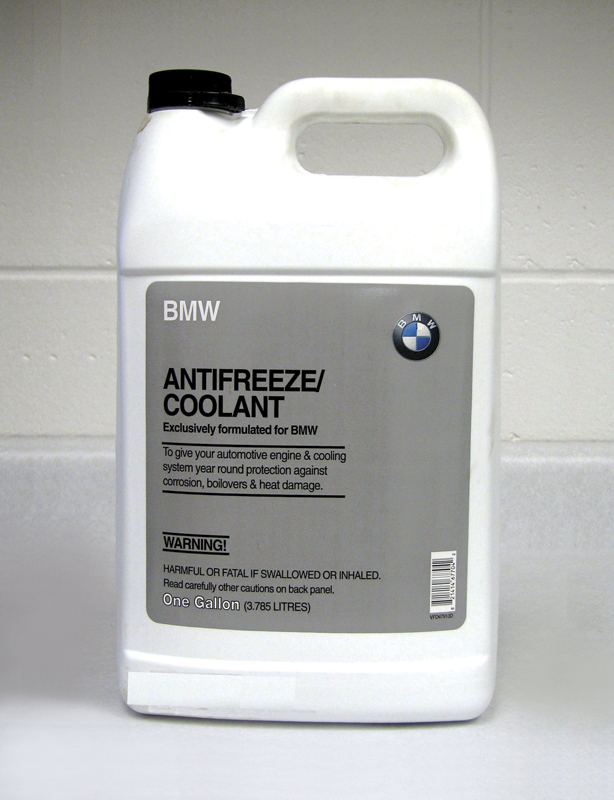
Give your customers optimal cooling system protection by using only BMW brand coolant. The standard 50/50 mix is correct unless your customers’ vehicles are exposed to extremely cold weather.
BMW’s engineers are prudent where maintenance is concerned. So, they’re sticking with the sensible recommendation that the coolant be changed every three years for maximum protection. Sound wisdom in our opinion, and something you can easily justify to your customers. The one-gallon container carries Part Number 82 14 1 467 704.
You can mix with other brands for topping off, but only if the other product does not contain any nitrites or phosphates, nor has a high-silicate formulation, so read the label carefully.
The factory fill is the standard 50% coolant/50% water mixture, which protects down to -34o F (-37o C). In severely cold areas, where -34o F (-37o C) isn’t enough, you can increase the mixture to 60% coolant/40% water, which protects to -62o F (-52o C). Or, you could consider moving. Under no circumstances should you ever exceed a 60% coolant/40% water ratio. Ironically, mixtures with more than 60% coolant actually reduce, not increase, freezing protection.
By the way, it’s very important to go the extra mile for your customers and use only distilled or de-ionized water in the mix. This will differentiate you from your competitors, and will go a long way in preventing deposit formation.
BMW does not approve the use of any coolant additives, including those intended to improve corrosion resistance or seal minor leaks.
Brake Fluid
Only glycol-based, DOT 4 brake fluid is approved. BMW sells its brake fluid in 12 oz. (P/N 81 22 0 142 156) or one-gallon (P/N 81 22 0 142 155) containers.
Brake fluid should be completely flushed and replaced at least every two years (have you priced a replacement ABS unit lately?). Bleed the entire brake system, not just the master cylinder, because vapor bubbles and corrosion typically start in the calipers. Flush the system with all bleeder valves open and continue flushing until all fluid from the bleeders is clear and free of bubbles. When flushing the brakes, also flush the hydraulic clutch system.
Power Steering Fluid
Dexron III Automatic Transmission Fluid is used in both ball and nut and rack and pinion power steering systems. BMW has no recommended change interval for power steering fluid. Fluid normally is added only during repairs. That’s an especially good time, however, to flush the system because there are probably particles of debris in the fluid that can cause problems in spite of new parts.
Manual Gear Lube
BMW has four recommendations for manual transmission oil depending on the year and model.
- If there is no tag on the transmission bell housing, you can use any reputable brand of mineral-based transmission or gear lube oil with a SAE 80 viscosity rating. The lube must meet a MIL-L-215 and/or API GL-4 rating.
- For 325e and 528e manual transmissions produced before mid-1986 and without a dual mass flywheel, use Mobil SHC 630 synthetic transmission fluid. These transmissions should have a green label “Special Oil†affixed next to the oil drain plug.
- Dexron III can be used on manual transmissions with dual mass flywheels, direct drive 5th gear after 9/90, or on six-speed transmissions. These transmissions will have an orange label on the bell housing that reads:
ATF-Oil!
Automatic Transmission Fluid - On some 1998 cars, if there is a yellow label, “MTF-LT-1†use Exxon MTF-LT-1 lifetime fluid.
Always use the transmission lube recommended by BMW. No other brands are approved. And never use a synthetic transmission lube in a manual transmission unless specifically called for. Premature wear will result because the synchronizers in other transmissions are not compatible with synthetic oil — there will not be enough friction present for the blocking rings to do their job.
ATF
If the vehicle has one of the General Motors automatic transmissions used by BMW, the fluid choice is easy—any quality brand of Dexron III. No other fluid is approved for the GM automatics. GM transmission can be identified by the following codes:
- A4S 270R (THM-RIW), A4S 310R (THM-R1), A5S 360R (GM5), and A5S390R (GM5).
If the vehicle has a ZF automatic, things are not as simple:
- ZF 3 HP22, 4HP22, and 4HP24 transmissions require Castrol TQ or Havoline Dexron III.
- The A5S 310Z (5HP18) used on the 1995-1999 M3 uses Esso LT 71141 synthetic ATF available as BMW (P/N 83 22 9 407 807).
- The A5S 310Z (5HP18) used on the 1993-1995 520i/iT uses Castrol TQ or Havoline Dexron III.
- A5S325Z (5HP19) takes Esso LT 71141 synthetic ATF.
- A5S 440Z (5HP24) transmission Esso LT 71141 synthetic ATF.
- The A5S 560Z (5HP30) used on the 840ci with the M60 engine; the 740i/il from 1993 to 1994, the 540i/iT from 1993 to 1995; takes Shell LA 2634, available as BMW (P/N 83 22 9 407 765).
- The A5S 560Z (5HP30) used on the 840Ci equipped with the M62 engine and the 850Ci with the M73 engine; 805Ci from 10/94 to 6/97; 840Ci from 12/95 to 8/96; 750iL from 1/95 to present; 740i/iL 7/94 to 12/96; 540i/iT 3/96 to 12/96 requires Esso LT 711 41.
- GA6HP19Z; GA6HP26Z; and GA6HP26Z automatics require Shell M-1375, available from BMW as (P/N 83 22 0 142 516).
Although the variations in ATF can be confusing, pay close attention to the transmission model and application so you use the right fluid. BMW states that only the specified ATF must be used and that ATFs cannot be mixed.
Check the owner’s or service manual for ATF change intervals. Many BMW automatics, especially those in later models, have no ATF change interval. Fluid is added or replaced only when the transmission is repaired. Of course, it’s common wisdom in the auto service business that ATF changes every 30,000 miles go a long way in preventing eventual failures.
Differential Oil
For vehicles with limited slip differentials, BMW has a new synthetic final drive oil, BMW SAF-XJ (P/N 83 22 1 470 080), which replaces the old SAF-XLS. Although in-stock supplies of the old oil can be used in most models, the Z3 must use SAF-XJ.
For vehicles without a limited slip differential, use BMW SAF-XO synthetic oil (P/N 83 22 9 407 768).
Convertibles and Sun Roofs
There are three different BMW convertible top hydraulic fluids:
- On the E36/7 models, use (P/N 54 34 8 410 306).
- On the E46 models, use (P/N 54 34 7 117 733).
- On the E52, use (P/N 54 34 8 234 324).
- On the E85, use (P/N 54 34 7 117 733).
- On the E64, use (P/N 54 34 7 117 733)
Check vehicle service or owner’s manual if you have any question about the correct maintenance fluid for any application. All of the recommended fluids are available from any BMW dealer.



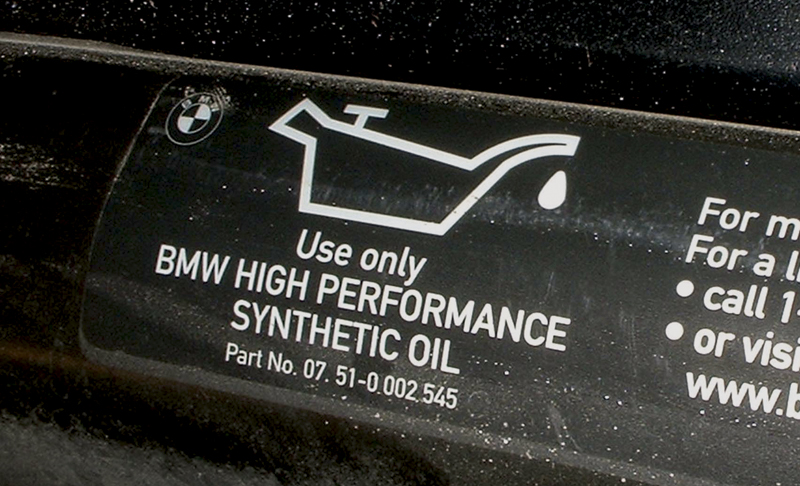
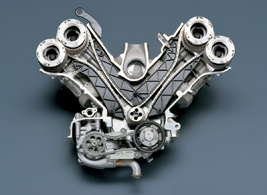
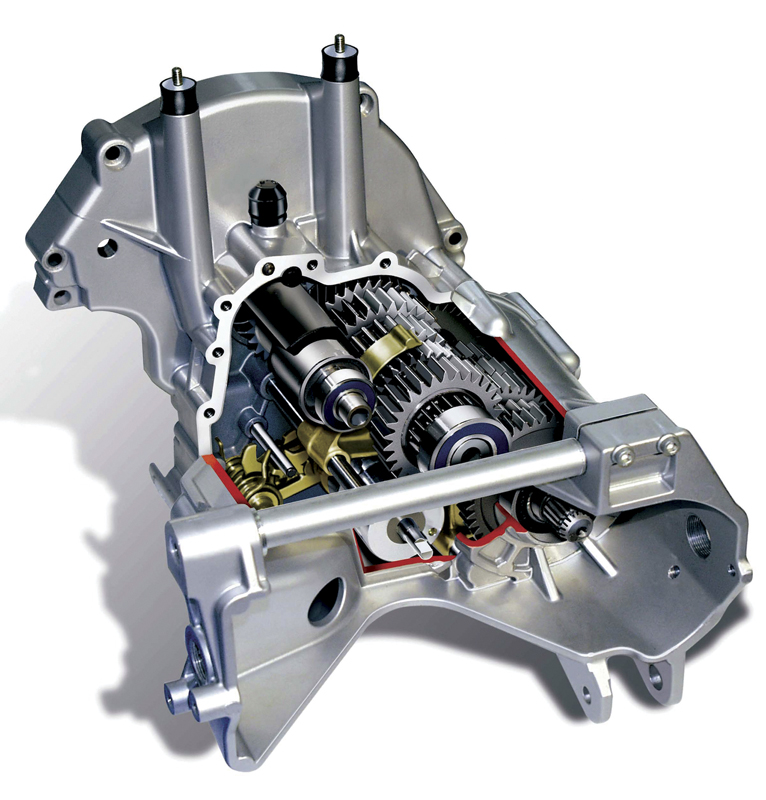
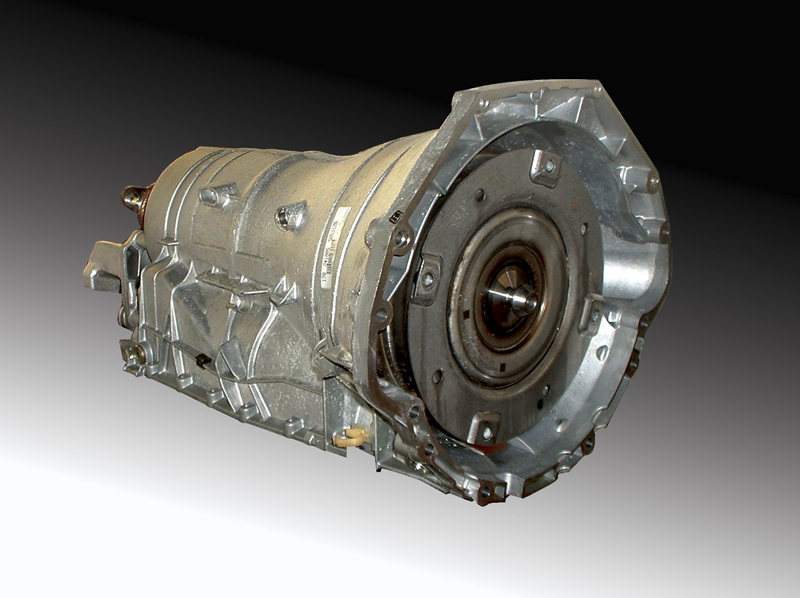
0 Comments